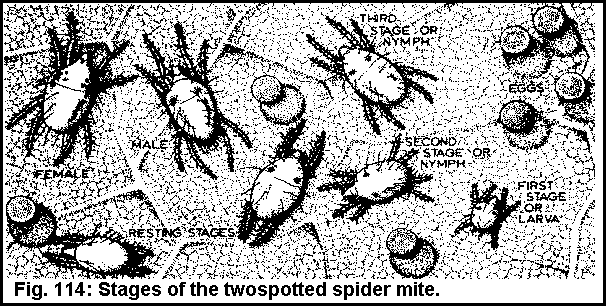Tetranychus urticae Koch, Tetranychidae, PROSTIGMATA

Return to: MREC Home Page
Return to: index
Insect and Related Pests of
Flowers and Foliage Plants
Published by the North Carolina Extension Service
DESCRIPTION
Adult- The eight-legged adult can be pale green, greenish amber, or yellowish. Usually having two (sometimes four) black spots on top, the twospotted spider mite is about 0.4 mm long.
Egg- The spherical egg ranges from transparent and colorless to opaque straw yellow.
Larva- The six-legged larva is colorless, pale green, or yellow.
Nymph- Similar to the adult except in size, the nymph has eight legs and is pale green to brownish green. Large black spots may develop on each side.
Fig. 114: Twospotted Spider Mite,
Tetranychus urticae Koch, Tetranychidae,
PROSTIGMATA 
Stages of the twospotted spider mite.
BIOLOGY
Distribution- Twospotted spider mites are widely distributed in the United States. Reports have shown the Piedmont and Coastal Plain regions of the Southeast to be the most heavily infested areas.
Host Plants- Twospotted spider mites have been reported on over 300 host plants, that include over 100 cultivated species. Violets, chickweed, pokeweed, wild mustard, henbit, vetch, and blackberry are common foci from which infestations develop on nearby crops.
Damage- Twospotted spider mites pierce the epidermis of the host plant leaf with their sharp, slender mouthparts. When they extract the sap, the mesophyll tissue of the leaf collapses in the area of the puncture. Soon a chlorotic spot forms at each feeding site. After a heavy attack, an entire plant may become yellowed, bronzed, or killed completely. The mites may completely web over entire plants.
Life History- Twospotted spider mites are important pests on more crops than any other arthropod in the Southeast. Though insects and mites are in a group called the Arthropoda (meaning jointed foot) because jointed legs are common to both, spider mites are not actually insects. They are more closely related to spiders, and they derive their name from the thin web which some species spin.
In North Carolina, twospotted spider mites overwinter as adults in the soil or on weed hosts such as violets, henbit, and hollyhocks. In mild winter weather, twospotted spider mites continue to feed and lay eggs, although development in the winter is much slower than in the summer. From the eggs hatch six-legged larvae. They develop into eight-legged nymphs which pass through two nymphal stages. After each larval and nymphal stage, there is a resting stage. The adults mate soon after emerging from the last resting stage, and in warm weather the females soon lay eggs. Each female may lay over 100 eggs in her life and up to 19 eggs per day. Development is rapid in hot, dry weather. Each generation may take as many as 20 or as few as 5 days to mature.
They often damage one species of plant quite heavily and then disperse to other hosts. When a plant is heavily damaged, the mites migrate to the outer periphery of the plant. From here, even the gentlest of breezes can carry them a significant distance to attack new hosts.
CONTROL
The use of foliar insecticides in hot, dry weather can induce spider mite outbreaks by killing the beneficial arthropods that would normally feed on the mites. In addition, a fungal pathogen attacks spider mites following short periods of cool, damp weather. Certain fungicides can eliminate this fungus and should be avoided for several weeks if plants are infested and such conditions occur. If spider mite infestations are detected early enough, a daily misting or spraying with a garden hose can be an effective control.
The resting stages and eggs of the twospotted spider mite are more tolerant to pesticides than the motile forms. Consequently, a second application of pesticide may be necessary at 4- or 5-day intervals in hot weather (7 to 10 days in cool weather) to kill those mites that may have survived the first application. For specific chemical control recommendations, see your Cooperative Extension publications on ornamental plant pest management or consult your Extension agent.
University of Florida, Central Florida Research
and Education Center - Apopka
Small
thumbnail plates of the twospotted
spider mite and predator.
University of Florida, Central Florida Research
and Education Center - Apopka
Biocontrol
of the twospotted spider mite Including
thumbnail plates linked to much larger views.
University of Florida/IFAS Pest Control Guides